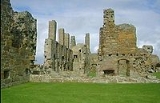
Earl's Palace, Birsay
Encyclopedia

Birsay
Birsay is a parish in the north west corner of The Mainland of Orkney, Scotland. Almost all the land in the parish is devoted to agriculture: chiefly grassland used to rear beef cattle...
, Orkney, Scotland
Scotland
Scotland is a country that is part of the United Kingdom. Occupying the northern third of the island of Great Britain, it shares a border with England to the south and is bounded by the North Sea to the east, the Atlantic Ocean to the north and west, and the North Channel and Irish Sea to the...
, is a ruined 16th-century castle
Castle
A castle is a type of fortified structure built in Europe and the Middle East during the Middle Ages by European nobility. Scholars debate the scope of the word castle, but usually consider it to be the private fortified residence of a lord or noble...
. It was built by Robert Stewart, 1st Earl of Orkney
Robert Stewart, 1st Earl of Orkney
Robert Stewart, Knt., 1st Earl of Orkney and Lord of Zetland was a recognized illegitimate son of James V, King of Scotland, and his mistress Eupheme Elphinstone....
(1533–1593), illegitimate son of King James V
James V of Scotland
James V was King of Scots from 9 September 1513 until his death, which followed the Scottish defeat at the Battle of Solway Moss...
and his mistress Euphemia Elphinstone
Euphemia Elphinstone
Euphemia Elphinstone was a mistress of James V of Scotland and the mother of his son Robert Stewart, 1st Earl of Orkney, born in 1532, as well as another royal bastard who died in childhood...
. The palace is a category A listed building and a Scheduled Ancient Monument
Scheduled Ancient Monument
In the United Kingdom, a scheduled monument is a 'nationally important' archaeological site or historic building, given protection against unauthorized change. The various pieces of legislation used for legally protecting heritage assets from damage and destruction are grouped under the term...
, and is in the care of Historic Scotland
Historic Scotland
Historic Scotland is an executive agency of the Scottish Government, responsible for historic monuments in Scotland.-Role:As its website states:...
.
History
The castle was constructed in two phases. The first phase of work, begun in the 1570s, consisted of the great hall located in the south range, above the main door. Beside this was Lord Orkney's private chamber in the south-east corner tower. An inscription above the entrance, dated 1574, marks this phase. The second phase, completed in the 1580s, saw a new range containing a great hall and chamber built on the north side of the courtyard. The second phase probably followed Robert's acquisition of the Earldom of OrkneyEarl of Orkney
The Earl of Orkney was originally a Norse jarl ruling Orkney, Shetland and parts of Caithness and Sutherland. The Earls were periodically subject to the kings of Norway for the Northern Isles, and later also to the kings of Alba for those parts of their territory in mainland Scotland . The Earl's...
in 1581. After the death of Robert Stewart, the palace was used only occasionally by later earls of Orkney, and was not occupied after the mid-17th century. By 1701 the palace had begun to deteriorate badly.
The castle
The two-storey palace was constructed around a central courtyard and well, with large stone towers at three of the four corners. It was as much a fortress as a residence. Only the palace's upper floors had large windows; the accessible ground floors were equipped with small openings and an array of gun-holes, from which musketeerMusketeer
A musketeer was an early modern type of infantry soldier equipped with a musket. Musketeers were an important part of early modern armies, particularly in Europe. They sometimes could fight on horseback, like a dragoon or a cavalryman...
s could cover every side of the building.
Few records of the palace remain to give a clear impression of its contents and layout. The Reverend John Brand published a book about Orkney in 1701, and included a description of the palace. He wrote:
External links
- The Earl's Palace, Birsay, Orkneyjar

